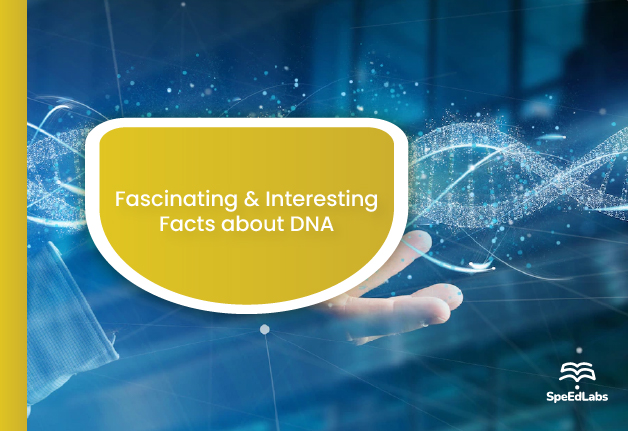Humans and nearly all other organisms carry their genetic information in DNA, also known as deoxyribonucleic acid. The DNA of an individual can be found in almost all of their cells. The majority of DNA is found in the cell nucleus (where it is known as nuclear DNA), but there is also a small amount of DNA in the mitochondria (where it is called mitochondrial DNA or mtDNA).
DNA is the building block of life. However, do you know there are so many fascinating facts about DNA?
Interesting Facts about DNA
- Your DNA is long enough to travel 600 times from the earth to the sun and back.
The DNA strands in each of your cells are 6 feet long if they were unwound and linked together. Your body contains 100 trillion cells, which translates to a length of more than 110 billion miles if your DNA were to be arranged end to end. That entails many trips around the sun!
- We are alike in 99.9% of ways.
Only 0.1 per cent of the 3 billion base pairs in the human genome are specific to each individual. We are still all different in that 0.1 per cent, but overall, we are more alike than we are different.
- Only about 3% of your DNA is made up of genes.
While not all DNA is made up of genes, genes are brief segments of DNA. Genes make up only 1-3 per cent of your DNA in total. The remaining portions of your DNA govern your genes’ activity.
- You may be more Indian than your siblings as per a DNA test!
There is a chance your sister is more Indian than you are.
- The 3 billion DNA base pairs that make up the human genome.
DNA molecules have a twisted ladder-like shape. The bases adenine (A), cytosine (C), guanine (G), and thymine (T) are joined in pairs by hydrogen bonds to form the rungs of that ladder. The cool thing about them is that they always pair with the same letters: “A” always goes with “T,” and “C” always goes with “G.”
- Red blood cells are the only cells in the body without DNA; they develop from DNA.
- Bananas and humans have a 60% DNA similarity.
- Chimpanzees and humans share 98 per cent of their DNA, while garden cabbage and humans share 50 per cent.
- Typing at a rate of 60 words per minute for eight hours a day would take almost 50 years to complete the human genome sequence.
- DNA is Fragile
Every day, something happens to it that results in errors about a thousand times.
This might involve transcription errors, ultraviolet light damage, or a variety of other things. Despite numerous repair options, some damage cannot be fixed. You have mutations, then! While some mutations are beneficial and do no harm, others can lead to diseases like cancer. With the help of a new technology called CRISPR, we may be able to edit genomes and, theoretically, cure any disease that has a genetic component, including cancer, Alzheimer’s, and other mutations.
- The DNA of identical twins is the same. However, due to the environment and lifestyle choices that affect gene expression, twins do not look exactly alike.
- In 1869, Friedrich Miescher made the DNA discovery. It was not recognised as genetic data until 1943, though. Before 1943, the majority of scientists believed that proteins held the genetic code. On April 25, 1953, British molecular biologists Francis Crick and James Watson discovered the structure of DNA.
- DNA knowledge became dangerous because “designer babies” might be produced. Genome research raised worries that such activity could not only correct genetic flaws but could also give parents a say in the characteristics of their offspring. These alterations may take many forms, from changes in intelligence level to eye and hair colour.
- Approximately 8% of the human genome is made up of junk DNA.
It contains traces of the viral genome that originated from the same microorganisms that previously infected ancestors. In other words, the viruses that once sickened your family members are now present in your DNA. so genetic illnesses.
- Only in 2000 was the first draft of the human genome map finished by scientists.
An incredible innovation that has the potential to revolutionise medicine was produced by the cooperation of two competing scientific groups. Doctors provide diagnoses and recommend treatments that are uniquely tailored to the requirements of each patient.
- They finished the series in 2003.
Although it was far from an easy or simple task, researchers from the Human Genome Project succeeded in deciphering the entire sequence three years after its initial draught. This accomplishment opened the door to the idea of explaining a genetic similarity between humans or other model organisms.
- In criminal cases, DNA testing was first applied in 1985.
The first victim of its justice was the Florida rapist Tommie Lee Andrews in 1987. A Virginia serial killer from 1988 comes next.
- Naturally, the octopus could change its genes.
Scientists were able to create CRISPR-Cas9, a complicated tool with a protein basis, although it is extremely unlikely for humans. This mechanism might change the DNA of a damaged embryo, preventing inherited diseases.
Also published on Medium.
